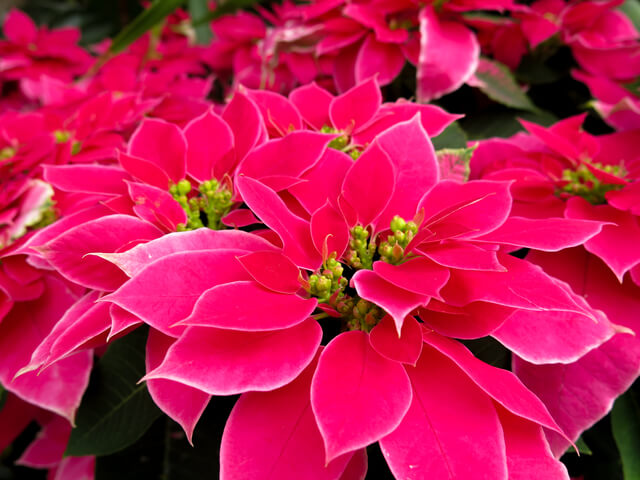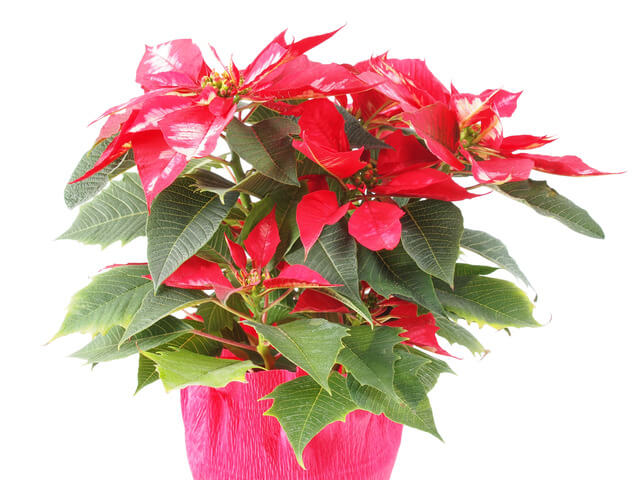Poinsettias are the popular holiday plants because they are commonly used in the winter holidays for decoration from porches of homes to beautiful churches and are attractive as green plants throughout the year.
Coming from the Euphorbia family and being native to Mexico, and Central America where it was used by the Aztecs for decorative and medicinal purposes, the colorful flowers are its modified leaves known as bracts. There is also a species of poinsettias used as cut flowers.
The poinsettia plant is generally a shrub that grows in a cluster and the flowers are made up of bracts that look like a petal and change color in response to the short winter days. Besides, it possesses a tiny yellow flower in the center known as the Cyathia. The colorful bracts attract the insects towards themselves and help in pollination.
Also named Mexican Flameleaf, Poinsettias are not harmful to human health and animals. However, they can’t be eaten.
Being a decorative plant, it comes in many colors like creamy white, pink, red, white, bright orange, salmon, blue, and, purple, etc. some of these plants also look spray-painted and sprinkled with glitters.
To keep the plant beautiful, healthy, and cherry-like appearance. The plant should be given proper care. So we have created the growing and caring guide of the poinsettia plant for the gardeners who want to bring this beautiful plant to their homes.
Types of poinsettias
Apart from the traditional red bracts, there are a variety of hybrids of these plants that come in colorful shades like white, cream, yellow, salmon, purple, burgundy, and pink.
Besides these usual colors, there are some colorful varieties of poinsettias are available that can bring beauty to your garden. That variety includes;
To keep the plant beautiful, healthy, and cherry-like appearance. The plant should be given proper care. Click To TweetPlum pudding
The first purple-colored variety of poinsettias was introduced to the market.
Jingle bells
These plants have red bracts with creamy white markings splashed into them.
Lemon drop
This variety of the plant is Cheery varietal with yellow bracts.

how to care for the Poinsettia plant?
Poinsettia plants are the most popular indoor potted plants during the holidays as it grows well during these days. So with proper care, this plant can maintain its beauty for a longer period.
So here is some caring guide for these plants.
Light
Being native to a tropical region, the poinsettias are used to a fairly amount of sun and grows well in partial sunlight. It requires diffused sunlight for 4 to 6 hours daily. Although the plants grow well in fewer hours of light, the growing plant can’t be vigorous and dies early. Likewise, exposing it to bright sunlight might kill its bract and leaves.
If you are growing the plant indoors, then keep it in a place near the window where it can get direct bright sunlight.
Soil
If you are planting or repotting the plant into the soil, the well-drained peat-based potting soil is best for its growth. But if you are buying a plant directly, then you should purchase it with the soil.
Temperature
Poinsettias thrive well in high temperatures. So they require 65 to 70 degrees Fahrenheit of temperature to grow. They don’t like to grow in lower temperatures. So if they are exposed to freezing temperature, they tend to die. So it is required to keep away the plant from the areas where the temperature is below 50 degrees Fahrenheit.
Besides that, fluctuating temperature also may kill the poinsettia plants. So avoid placing this plant where the temperature fluctuates or maybe dry, such as near cold drafts, heat ducts, fireplaces, fans, space heaters, etc.
Water
Watering is very necessary for a poinsettia plant. But water the plant as much as necessary. Keep the soil moist, not soggy. Never allows the roots of the plant to sit on excess water. This may cause root rot in the plant.
When the soil where the plant is planted becomes dry, the container feels light, or the leaves start wilting, water the plant immediately. Make sure the container should drain the water freely. Water the plant regularly, when the surroundings of the plant tend to dry.
Water the plant continuously from January to march as they require more water during this time.
Fertilizing poinsettias plant is not necessary during the winter holidays. You should fertilize the plant during the plant starts new growth like new stems, bracts, and leaves. Click To TweetFertilizer
Fertilizing the plant is not necessary during the winter holidays. You should fertilize the plant during the plant starts new growth like new stems, bracts, and leaves.
If you are fertilizing the plant, make sure to fertilize it with an all-purpose household plant fertilizer every 3-4 weeks to keep the plant healthy and provide the essential nutrients for its growth.
Humidity
Poinsettias require high humidity. Lack of humidity especially in dry seasons like winter can create a measure problem for houseplants including the poinsettia plants. So if your place tends to dry easily, then place a small space humidifier to increase humidity levels in the area surrounding your poinsettia.

Repotting of poinsettia plant
Repotting of the poinsettia plant is necessary to ensure healthy growth and spreading of the plant.
Repotting should be done in late spring and early summer by transplanting the plant into a large container or a garden bed.
The process of the repotting of the poinsettia plant is discussed below
Prepare the soil for the plant in a pot by adding some organic matter like peat moss and ensure that the pot has a good drainage system. If you are planting the poinsettia into the garden, then prepare the soil of the garden by adding some compost and organic matter to it and keeping it dry for some hours.
Water the plant thoroughly after repotting.
how to repot a poinsettia plant?
These plants can be propagated from the seeds. As most of the cultivars are hybrids, which can result in the seedlings that can be unpredictable in terms of their genetics and resulting appearance, it is preferable to propagate the plant through stem cutting.
Stem cutting can be done by cutting the stem of a growing plant during winters. It is also recommended to wait till the summer to cut the stems as new stems grow from the plant during this time and can be used for propagation.
Besides, when the plant is producing new growths after emerging from the dormancy, stem cutting can be done and can be planted with the help of a rooting hormone.
Common pests and diseases
Like other indoor plants, the poinsettia is also exposed to a lot of insects and pests that include gnats, whiteflies, thrips, mealybugs, and powdery mildew. So if you notice the sign of illness or infection by these pests. Then remove the affected area from the plant as soon as possible and treat it with the ideal insecticide until all the signs disappear.
Problems related to the poinsettia plant
Leaves are falling off
If the leaves of the poinsettia are falling off or it defoliates, it is not a good sign of growth. It may be caused due to some water problems like underwatering or overwatering. It might also be caused due to overfertilizing the plant. If some leaves are falling, it may be caused due to getting an inappropriate amount of light.
Leaves turning yellow
If the leaves of a plant are turning yellow, it may be caused due to increased stress on the plant. The leaves of a plant can be turned yellow due to inappropriate fertilizing like overfertilizing or by lack of a particular nutrient.
It is also caused if the growing soil medium is too acidic or the plant is overwatered and gets less light or less temperature.
Besides that, if the powdery mildew tends to grow on it, it can turn the leaves yellow.
Leaves or stems turning brown
The leaves and stem of a poinsettia plant become brown if the roots of the plant start rotting. This can be cured by repotting the plant in another healthier medium in clean soil.

Concluding thoughts
If you have come so far reading this article, I hope you must have got an idea of how to grow and care for these amazing and beautiful poinsettia plants. So why so delay?
why don’t you add these poinsettia plants to your indoor plants’ list and enjoy their beauty and essence in the coming Christmas winter holidays?
Poinsettia plants are stunning houseplants because of their colorful bracts and beautiful appearance. As these are easily grown you can also gift these plants to your friends as well. With proper care, your poinsettia plants will surely reward you with beautiful looks in your garden.







One thought on “How to grow and care for poinsettia plant-A step by step guide”
I reviewed your blog it’s really good. Thanks a lot for the information about this blog.I want more informations.